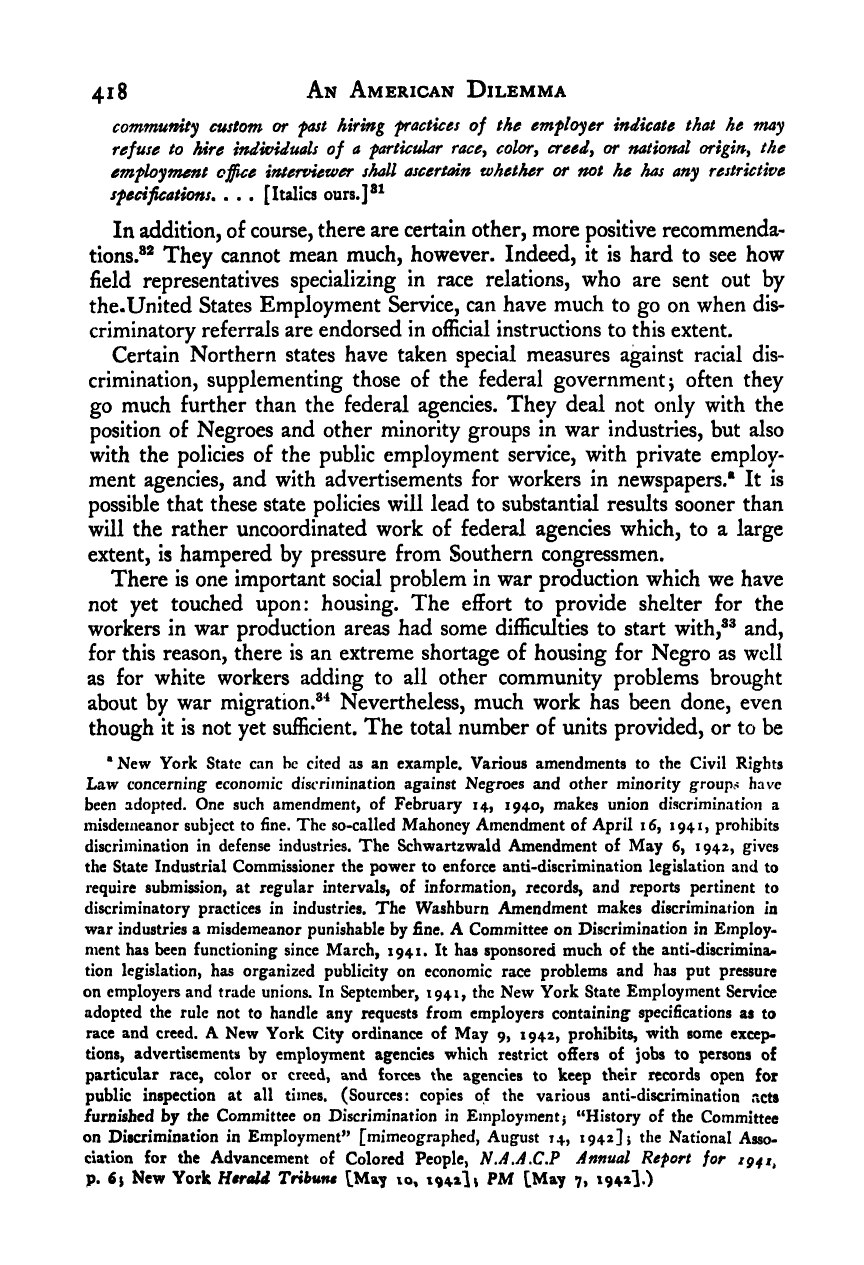Note: Gunnar Myrdal died in 1987, less than 70 years ago. Therefore, this work is protected by copyright, restricting your legal rights to reproduce it. However, you are welcome to view it on screen, as you do now. Read more about copyright.
Full resolution (TIFF) - On this page / på denna sida - IV. Economics - 19. The War Boom—and Thereafter - 3. Government Policy in Regard to the Negro in War Production

<< prev. page << föreg. sida << >> nästa sida >> next page >>
Below is the raw OCR text
from the above scanned image.
Do you see an error? Proofread the page now!
Här nedan syns maskintolkade texten från faksimilbilden ovan.
Ser du något fel? Korrekturläs sidan nu!
This page has never been proofread. / Denna sida har aldrig korrekturlästs.
41
8
An American Dilemma
community custom or fast hiring fractices of the emfloyer indicate that he may
refuse to hire individuals of a farticular race^ colors creeds or national origin^ the
emfloyment office interviewer shall ascertain whether or not he has any restrictive
sfecifications. . . , [Italics ours.]®^
In addition, of course, there are certain other, more positive recommenda-
tions.®^ They cannot mean much, however. Indeed, it is hard to see how
field representatives specializing in race relations, who are sent out by
the-United States Employment Service, can have much to go on when dis-
criminatory referrals are endorsed in official instructions to this extent.
Certain Northern states have taken special measures against racial dis-
crimination, supplementing those of the federal government j
often they
go much further than the federal agencies. They deal not only with the
position of Negroes and other minority groups in war industries, but also
with the policies of the public employment service, with private employ-
ment agencies, and with advertisements for workers in newspapers.® It is
possible that these state policies will lead to substantial results sooner than
will the rather uncoordinated work of federal agencies which, to a large
extent, is hampered by pressure from Southern congressmen.
There is one important social problem in war production which we have
not yet touched upon: housing. The effort to provide shelter for the
workers in war production areas had some difficulties to start with,®® and,
for this reason, there is an extreme shortage of housing for Negro as well
as for white workers adding to all other community problems brought
about by war migration.®^ Nevertheless, much work has been done, even
though it is not yet sufficient. The total number of units provided, or to be
“New York State can be cited as an example. Various amendments to the Civil Rights
Law concerning economic discrimination against Negroes and other minority groups have
been adopted. One such amendment, of February 14, 1940, makes union discrimination a
misdemeanor subject to fine. The so-called Mahoney Amendment of April 16, 1941, prohibits
discrimination in defense industries. The Schwartzwald Amendment of May 6, 1942, gives
the State Industrial Commissioner the power to enforce anti-discrimination legislation and to
require submission, at regular intervals, of information, records, and reports pertinent to
discriminatory practices in industries. The Washburn Amendment makes discrimination in
war industries a misdemeanor punishable by £ne. A Committee on Discrimination in Employ-
ment has been functioning since March, 1941. It has sponsored much of the anti-discrimina-
tion legislation, has organized publicity on economic race problems and has put pressure
on employers and trade unions. In September, 1941, the New York State Employment Service
adopted the rule not to handle any requests from employers containing specifications as to
race and creed. A New York City ordinance of May 9, 1942, prohibits, with some excep-
tions, advertisements by employment agencies which restrict offers of jobs to persons of
particular race, color or creed, and forces the agencies to keep their records open for
public inspection at all times. (Sources: copies of the various anti-discrimination acts
furnished by the Committee on Discrimination in Employment} “History of the Committee
on Discrimination in Employment’* [mimeographed, August 14, 1942]} the National Asso-
ciation for the Advancement of Colored People, N.A,A.C,P Annual Refort for 1941^
p. 6} New York Herald Tribune ^May 10, 1942! 1 PM [May 7, 19423.)
<< prev. page << föreg. sida << >> nästa sida >> next page >>